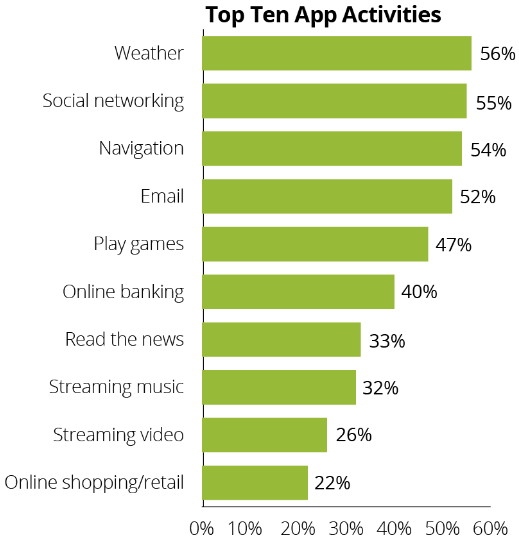
![top ten app activities]() What makes for a popular app?
What makes for a popular app?
The same report highlighted the top ten app activities, ranging from checking the weather, accessing social media, playing games, reading the news and streaming video. The similarity? They’re all things that we do regularly, and, for the most part, for fun.The difference between these activities, and what most businesses are trying to achieve in developing an app, is that business apps typically want something from you in order to help them.That could be a meter reading, registering your interest in an event or course, updating contact information, paying a bill, upgrading your account, booking an appointment etc.They’re all things we do when we *have* to, rather than when we *want* to.
Why apps are so appealing
The principles of behaviour led design dictate that in order to someone to complete an activity, you must have achieved the following:
- They must be sufficiently motivated
- It must be relatively easy for them to complete the activity
- There needs to be a trigger to prompt the activity.
An app absolutely nails point no. 2 – the user experience of completing a form on an app is vastly superior to completing a form on a website (even if that site is mobile optimised), and much more convenient than having to make a call or email.
Is the only way app?
Fortunately, no: if your objective is to get your customers to *do* something for you, a mobile web app such as Esendex’s Mobile Journeys platform delivers an app-like user experience but without the need to develop, market and maintain a native app.Mobile web apps are accessed via a URL similar to https://ems.ese.pm/Esendex_YiK (this is a link to a sample Mobile Journey so do feel free to check it out!). They are built with the mobile user in mind, so all of the items that generally create friction when completing online forms are smoothed over.They’re extremely goal-focused, generally only having one purpose, and make self-service an appealing option for your customers.
The principles of behaviour led design:
- Motivation: this can take the form of a reward or the threat of a penalty. The beauty of a mobile web app is that you can combine the link to the application in the same message, delivered via email, SMS or even social media.
- Ability: as just mentioned, mobile web apps seek to make it as easy as possible for the user to complete a goal on a mobile.
- Trigger: whereas apps rely on push notifications being accepted, a mobile web app can be pushed out to customers at the right time and through the communication channel that best suits the customer.
So, in conclusion – before you commit to building an app, it’s most definitely worth exploring your options to see if a mobile web app would be less costly, more effective and tie in better with your overall communications strategy.Please do comment if you’ve had experience in building either sort of app, and how it worked out for you.

